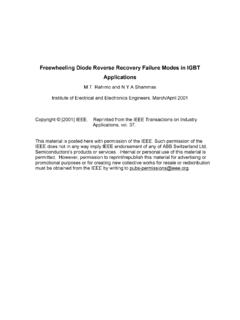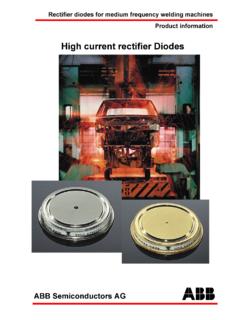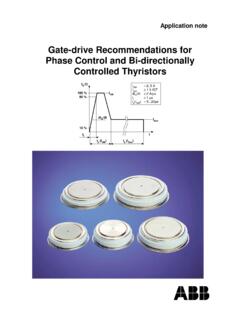Transcription of Simulation Tool for IGBT modules - 5S …
1 Simulation tool for igbt modulesR. SchnellABB Switzerland Ltd, Semiconductors, Fabrikstrasse 3, CH 5600 Lenzburg, Switzerlande-mail: has recently released a new Simulation tool based on Microsoft Excel for dimensioning of two levelvoltage source igbt tool allows the calculation of switching and conduction losses under the assumption of sinusoidaloutput currents. Additionally static and transient temperature rises in the module and an optionallyspecified heatsink can be calculated. The losses in the igbt and companion freewheeling diode areiteratively adjusted to the temperature the calculation results allow a quick selection of ABB igbt modules for the planned :The calculation of the conduction and switching lossesof the igbt and the freewheeling diode are done basedon the application application parameters the DC-link voltage, outputfrequency, switching frequency, modulation index andthe power factor cos can be the maximum permissible output current has to becalculated the junction and case or heatsink temperatureneeds to be specified.
2 In this case the permissible outputcurrent can be read out of a diagram or directlycalculated by using the the output current is given the Simulation toolcalculates with 10 iterations the losses and temperaturerise of the it is possible to calculate the temperaturerise in an optionally specified cooler. In addition specialoverload conditions can be specified and the simulationtool calculates the temperature excursion duringoverload in the heatsink and the module . Again thelosses are iteratively adjusted to the Calculation:The Simulation tool offers a relatively exact and fastmethod for loss model data for the igbt modules are based ontheir respective data-sheet calculations are done with a linear approximationof the devices forward characteristics and with apolynomial function of the igbt and diode switchingenergy. Additionally the forward and switching-energycharacteristics are temperature power dissipation calculation of the igbt anddiode are done by an average calculation for theconduction and switching losses over one period T0 ofthe output frequency.
3 This method does not requireadding up the switching energies [1]. igbt loss calculation: Since the igbt of one switchconducts only over one half period the conductionlosses are given by the integration of the forward losses(VCE0, rCE including RCC'+REE') up to T0/2: +=2/02000)())sin((1 TCECEIGBT conddttt rVTP with (t) as the function of pulse pattern with igbt turned-on=1 and igbt turned-off=0. (t) can besubstituted by a function of modulation (m) and phaseangle ( ).With an infinite switching frequency we get the dutycycle variation over time (PWM pattern).))sin(1(21)( ++=tmtInserting (t) into the formula and solving the integralwe get the conduction losses:)318(cos)4(202021 r Vm r VPCECECECE cond + + + = The Simulation tool restricts the modulation index tom The switching losses are the sum of all turn-on and turn-off energies at the switching measured turn-on and turn-off energies given in thedata-sheet can be described as a polynomial function(Esw=f(I)):)(2 IcIbaEEEoffonsw + +=+=Since the DC-link voltage can vary in differentapplications the dependence of the switching energy onthe DC-voltage needs to be considered.
4 Within certainlimits this dependence can be assumed linear:nomDCswVV c baE + +=)(2To calculate the switching losses the switching energieshave to be added up. =nswsw ETP)(10whereas n depends on the switching we can calculate the switching losses as afunction of phase-current and switching c bafP + + =)(12 The total igbt losses are the sum of the conduction-and switching losses:swcondIGBTPPP+=Diode loss calculation:The diode losses can be nearly calculated the same wayas the igbt . Since the freewheeling diode conductswhen the igbt is turned-off the function of the pulsepattern has to be negated:)318(cos)4(202021 r Vm r VPTTTF cond + + = In case of the diode the turn-on energy can be only the recovery energy counts. Therecovery energy given in the data-sheet diagram can bedescribed as a polynomial function:)(2 IcIbaErec + +=The recovery losses as a function of phase-current andswitching frequency and VDC can be written as:nomDCswrecVV c bafP + + =)(12 The total Diode losses are the sum of the conduction-and switching losses:swcondDiodePPP+=Thermal Calculation:The loss calculation yields in average losses over oneperiod of the output frequency.
5 In fact the losses perswitch only occurs during one half-period whereasduring the other half period the antagonist switch isproducing 1 shows in the upper graph a PWM choppedcurrent as it appears in case of a two level VSI. Inaddition the resulting junction temperature is shown(calculated with THIMP ). It is obvious that thejunction temperature oscillates with the frequency of theoutput current. In the lower graph the correspondinglosses Psmoothed (THIMP) are shown. As acomparison the calculated average losses (Pav) fromsimulation tool are given (dashed line).If the junction temperature is calculated withTjav = Pav * Rth evidently the peak value of junctiontemperature exceeds the result of Tj calculated with theaverage losses Pav. Therefore the calculation of Tj withaverage losses yields in a to optimistic order to minimize this inaccuracy the Simulation toolcalculates with Pmod which is two times the averagelosses Pav dissipated during one half period of the phasecurrent.
6 The resulting junction temperature Tjmod isshown in the lower graph of figure 1 and matches interms of the peak and bottom values quite well with thereal value of [s]P100105110115120125 TjPsmoothed [W]Pav [W]Pmod [W]Tjmod [ C]Tj av [ C] [s]Ic100105110115120125 TjIc [A]Tj [ C]Figure 1: junction temperature as a function of fOThe maximum junction temperature Tvj max in functionof the phase output current frequency fO can becalculated if the transient thermal resistance is known:refniffiAVvjTeeRPTiOiO+ = = 1122max112 With Tref as the reference heatsink temperature Th forbase-less modules or case temperature Tc for and Transient Calculations:In addition to the module calculation the Simulation toolallows the user to calculate the temperature rises andmodule losses of the igbt - module together with aspecified Simulation tool uses a simplified approach tocalculate temperature rises and cross-talk effects.
7 Thishas the advantage that the calculations can be done withthe given values in the module - and heatsink accurate methods based on finite elementcalculation require specific knowledge about moduleand cooler construction and need lots of time forparameter the other hand the simplified method of thesimulation tool allows quick and accurate simulationwithout detailed knowledge on cooler and equivalent block diagram:The simplification done in the Simulation tool is theassumption of common reference temperature pointwhere the temperature is assumed to be homogenousover the full area. In case of base-less devices thisreference is the heatsink temperature (figure 2):Base-less ModulesPIGBTZthJHPD iodeZthJHSwitch 1 PIGBTZthJHPD iodeZthJHSwitch nReference: ThZthHAFigure 2: thermal equivalent block diagram for base-less devicesThe static calculation of the temperature rise in theheatsink can be calculate with the thermal resistance ofthe cooler and the number of dissipating heat sourcesmounted on it:thHASD iodeIGBTAHRnPPTT ++=)(With nS as the number of switches mounted on based devices the reference is the case thermal characteristics of devices with a base-plate(copper or AlSiC) is normally specified with a ZthJC(thermal impedance junction case) for the igbt andDiode part.
8 Additionally the interface resistance case-heatsink RthCH is given for the whole module . Figure 3shows the thermal equivalent block diagram formodules with base-plate:Based ModulesPIGBTZthJCPD iodeZthJCSwitch 1 PIGBTZthJCPD iodeZthJCSwitch nReference: TcZthHARthCHFigure 3: thermal equivalent block diagram for devices with base-plateAs in case of base-less modules the static calculation ofthe temperature rise in the heatsink can be calculate withthe thermal resistance of the cooler and the number ofdissipating heat sources mounted on it:thHASD iodeIGBTAHRnPPTT ++=)(Additionally the temperature rise in the interface TCHneeds to be calculated. Since it is possible more thanone module is mounted on the heatsink and that the heatsources are distributed in several modules , as forexample in a three phase inverter built with three halve-bridge modules mounted on a single cooler, it becomesnecessary to scale the interface resistance accordingly:MthCHSD iodeIGBTCHnRnPPT += )(With nM as the number of modules mounted on a order to calculate the temperature dependentsemiconductor losses the Simulation tool adjusts thejunction temperature and the corresponding losses inseveral iterations.
9 Depending on the module type andthe calculation (with / without heatsink) the calculationstarts with the initial conditions Tvj = TA, Tvj = TH or Tvj= TC .Transient Overload Calculation:The Simulation tool offers the possibility to additionallycalculate the transient thermal behavior of the igbt module and the heatsink. For the transient calculationoverload conditions can be specified. In order to havefull flexibility the start conditions of the temperatureexcursion calculation need to be specified. This includesthe overload duration, the start junction temperature andthe start case or heatsink it is possible to study the transient thermalbehavior from any temperature level and even thethermal recovery behavior from an overload can transient temperature rise can be calculated with thethermal impedance. = =nitithieRtZ1/)1()( The temperature rise T(t) is a function of Zth(t) andthe temperature dependent power dissipation in thesemiconductor P(T).
10 ()()()()(tZTPtZRTtTthththstart + = In order to include the starting conditions for T thefirst term is introduced. Tstart/Rth describes the initialconstant power that resulted in Tstart. This depositedpower influences the thermal behavior untilZth(t)=Rth(t).The second term describes the heating with thetemperature dependant power P(T). Since T is as well afunction of the dissipated power and the thermalimpedance iterations are necessary to get an the transient heatsink temperature we can write:)()()()()(tZTPtZRTTTtTthHAthHAthHA AH startAH + +=whereas P(T) depends on the number of switchesmounted on the heatsinksDiodeIGBTnTPTPTP +=))()(()(For the transient average junction temperature we canwrite:)()()()()()(tZTPtZRTTtTtTthJHth JHthJHstartHstartvjHavvj + +=In case of modules with a base plate TH has to bereplaced with TC and RthJH and ZthJH have to be replacedwith RthJC and ZthJC respectively.)



